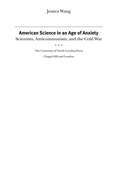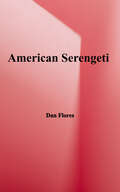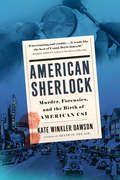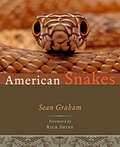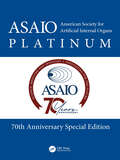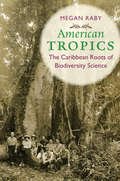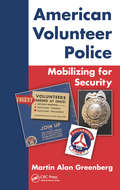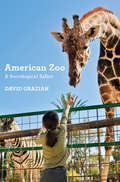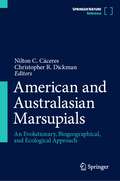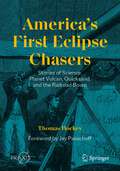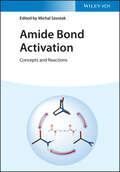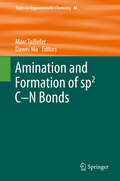- Table View
- List View
American Science in an Age of Anxiety
by Jessica WangNo professional group in the United States benefited more from World War II than the scientific community. After the atomic bombings of Hiroshima and Nagasaki, scientists enjoyed unprecedented public visibility and political influence as a new elite whose expertise now seemed critical to America's future. But as the United States grew committed to Cold War conflict with the Soviet Union and the ideology of anticommunism came to dominate American politics, scientists faced an increasingly vigorous regimen of security and loyalty clearances as well as the threat of intrusive investigations by the notorious House Committee on Un-American Activities and other government bodies.This book is the first major study of American scientists' encounters with Cold War anticommunism in the decade after World War II. By examining cases of individual scientists subjected to loyalty and security investigations, the organizational response of the scientific community to political attacks, and the relationships between Cold War ideology and postwar science policy, Jessica Wang demonstrates the stifling effects of anticommunist ideology on the politics of science. She exposes the deep divisions over the Cold War within the scientific community and provides a complex story of hard choices, a community in crisis, and roads not taken.
American Serengeti: The Last Big Animals of the Great Plains
by Dan FloresAmerica's Great Plains once possessed one of the grandest wildlife spectacles of the world, equaled only by such places as the Serengeti, the Masai Mara, or the veld of South Africa. Pronghorn antelope, gray wolves, bison, coyotes, wild horses, and grizzly bears: less than two hundred years ago these creatures existed in such abundance that John James Audubon was moved to write, "it is impossible to describe or even conceive the vast multitudes of these animals." In a work that is at once a lyrical evocation of that lost splendor and a detailed natural history of these charismatic species of the historic Great Plains, veteran naturalist and outdoorsman Dan Flores draws a vivid portrait of each of these animals in their glory--and tells the harrowing story of what happened to them at the hands of market hunters and ranchers and ultimately a federal killing program in the nineteenth and twentieth centuries. The Great Plains with its wildlife intact dazzled Americans and Europeans alike, prompting numerous literary tributes. American Serengeti takes its place alongside these celebratory works, showing us the grazers and predators of the plains against the vast opalescent distances, the blue mountains shimmering on the horizon, the great rippling tracts of yellowed grasslands. Far from the empty "flyover country" of recent times, this landscape is alive with a complex ecology at least 20,000 years old--a continental patrimony whose wonders may not be entirely lost, as recent efforts hold out hope of partial restoration of these historic species. Written by an author who has done breakthrough work on the histories of several of these animals--including bison, wild horses, and coyotes--American Serengeti is as rigorous in its research as it is intimate in its sense of wonder--the most deeply informed, closely observed view we have of the Great Plains' wild heritage.
American Sherlock: Murder, Forensics, and the Birth of American CSI
by Kate Winkler DawsonFrom the acclaimed author of Death in the Air ("Not since Devil in the White City has a book told such a harrowing tale"--Douglas Preston) comes the riveting story of the birth of criminal investigation in the twentieth century.Berkeley, California, 1933. In a lab filled with curiosities--beakers, microscopes, Bunsen burners, and hundreds upon hundreds of books--sat an investigator who would go on to crack at least two thousand cases in his forty-year career. Known as the "American Sherlock Holmes," Edward Oscar Heinrich was one of America's greatest--and first--forensic scientists, with an uncanny knack for finding clues, establishing evidence, and deducing answers with a skill that seemed almost supernatural.Heinrich was one of the nation's first expert witnesses, working in a time when the turmoil of Prohibition led to sensationalized crime reporting and only a small, systematic study of evidence. However with his brilliance, and commanding presence in both the courtroom and at crime scenes, Heinrich spearheaded the invention of a myriad of new forensic tools that police still use today, including blood spatter analysis, ballistics, lie-detector tests, and the use of fingerprints as courtroom evidence. His work, though not without its serious--some would say fatal--flaws, changed the course of American criminal investigation. Based on years of research and thousands of never-before-published primary source materials, American Sherlock captures the life of the man who pioneered the science our legal system now relies upon--as well as the limits of those techniques and the very human experts who wield them.
American Snakes
by Sean P. GrahamThe captivating and beautifully illustrated true story of snakes in America.125 million years ago on the floodplains of North America, a burrowing lizard started down the long evolutionary path of shedding its limbs. The 60-plus species of snakes found in Sean P. Graham's American Snakes have this ancestral journey to thank for their ubiquity, diversity, and beauty. Although many people fear them, snakes are as much a part of America's rich natural heritage as redwoods, bald eagles, and grizzly bears. Found from the vast Okefenokee Swamp to high alpine meadows, from hardwood canopies to the burning bottom of the Grand Canyon, these ultimate vertebrates are ecologically pivotal predators and quintessential survivors.In this revelatory and engaging meditation on American snakes, Graham, a respected herpetologist and gifted writer, • explains the everyday lives of American snakes, from their daily routines and seasonal cycles to their love lives, hunting tactics, and defensive repertoires• debunks harmful myths about snakes and explores their relationship with humans• highlights the contribution of snakes to the American wilderness• tells tales of "snake people"—important snake biologists with inspiring careersNeither a typical field guide nor an exhaustive reference, American Snakes is instead a fascinating study of the suborder Serpentes. Brimming with intriguing and unusual stories—of hognose snakes that roll over and play dead, blindsnakes with tiny vestigial lungs, rainbow-hued dipsadines, and wave-surfing sea-snakes—the text is interspersed with scores of gorgeous full-color images of snakes, from the scary to the sublime. This proud celebration of a diverse American wildlife group will make every reader, no matter how skeptical, into a genuine snake lover.
American Snakes
by Sean P. Graham“A wonderful book to read because it is replete with snake stories, personal stories, and stories about other herpetologists . . . engaging.” —CopeiaAlthough many people fear them, snakes are as much a part of America’s rich natural heritage as redwoods, bald eagles, and grizzly bears. Found from the vast Okefenokee Swamp to high alpine meadows, from hardwood canopies to the burning bottom of the Grand Canyon, these ultimate vertebrates are ecologically pivotal predators and quintessential survivors.In this revelatory and engaging meditation on American snakes, Sean P. Graham, a respected herpetologist and gifted writer,explains the everyday lives of American snakes, from their daily routines and seasonal cycles to their love lives, hunting tactics, and defensive repertoiresdebunks harmful myths about snakes and explores their relationship with humanshighlights the contribution of snakes to the American wildernesstells tales of “snake people”—important snake biologists with inspiring careersNeither a typical field guide nor an exhaustive reference, American Snakes is instead a fascinating study of the suborder Serpentes. Brimming with intriguing and unusual stories—of hognose snakes that roll over and play dead, blindsnakes with tiny vestigial lungs, rainbow-hued dipsadines, and wave-surfing sea-snakes—the text is interspersed with scores of gorgeous full-color images of snakes, from the scary to the sublime. This proud celebration of a diverse American wildlife group will make every reader, no matter how skeptical, into a genuine snake lover.“This thoroughly enjoyable book lets readers absorb the excitement of being a herpetologist who works with snakes while learning about the general and specific biology of the creatures.” —Quarterly Review of Biology
American Society for Artificial Internal Organs (ASAIO) Platinum 70th Anniversary Special Edition
by Pramod BondeThis book celebrates two decades of groundbreaking research published in the ASAIO Journal, marking significant advancements in artificial organs and circulatory support.The American Society for Artificial Internal Organs ASAIO Platinum 70th Anniversary book is a compilation of 50 of the top papers published in the ASAIO Journal over the last two decades that have contributed to the evolution of the field. The book includes tables listing the Top 100- cited, viewed, and downloaded, articles from the ASAIO Journal. It also lists the Top 10 Altmetric Scores by Year, 2015-2024. Topics range from artificial vision for the blind, and control systems for blood glucose, to the development of an artificial placenta IV and engineering 3D bio-artificial heart muscle, and much more. This book represents early ideas and concepts, new treatments and devices that changed future clinical care and some early concepts that challenge the status quo. With contributions from leading experts, the ASAIO 70th Anniversary Book serves as a comprehensive resource for anyone interested in the forefront of artificial organ technology and its impact on improving patient outcomes.This book is intended for clinicians, scientists, engineers, and academics working for the advancement and development of innovative medical device technologies.
American Tropics: The Caribbean Roots of Biodiversity Science (Flows, Migrations, and Exchanges)
by Megan RabyBiodiversity has been a key concept in international conservation since the 1980s, yet historians have paid little attention to its origins. Uncovering its roots in tropical fieldwork and the southward expansion of U.S. empire at the turn of the twentieth century, Megan Raby details how ecologists took advantage of growing U.S. landholdings in the circum-Caribbean by establishing permanent field stations for long-term, basic tropical research. From these outposts of U.S. science, a growing community of American "tropical biologists" developed both the key scientific concepts and the values embedded in the modern discourse of biodiversity.Considering U.S. biological fieldwork from the era of the Spanish-American War through the anticolonial movements of the 1960s and 1970s, this study combines the history of science, environmental history, and the history of U.S.–Caribbean and Latin American relations. In doing so, Raby sheds new light on the origins of contemporary scientific and environmentalist thought and brings to the forefront a surprisingly neglected history of twentieth-century U.S. science and empire.
American Volunteer Police: Mobilizing for Security
by Martin Alan GreenbergToday, it is estimated there are over 200,000 volunteers in police work throughout the United States. Although the need for such volunteers has never been greater, there is a lack of published materials regarding the nature of volunteer police work and how qualified citizens may augment police services. American Volunteer Police: Mobilizing for Sec
American Zoo
by David GrazianOrangutans swing from Kevlar-lined fire hoses. Giraffes feast on celebratory birthday cakes topped with carrots instead of candles. Hi-tech dinosaur robots growl among steel trees, while owls watch animated cartoons on old television sets. In American Zoo, sociologist David Grazian takes us on a safari through the contemporary zoo, alive with its many contradictions and strange wonders. Trading in his tweed jacket for a zoo uniform and a pair of muddy work boots, Grazian introduces us to zookeepers and animal rights activists, parents and toddlers, and the other human primates that make up the zoo's social world. He shows that in a major shift away from their unfortunate pasts, American zoos today emphasize naturalistic exhibits teeming with lush and immersive landscapes, breeding programs for endangered animals, and enrichment activities for their captive creatures. In doing so, zoos blur the imaginary boundaries we regularly use to separate culture from nature, humans from animals, and civilization from the wild. At the same time, zoos manage a wilderness of competing priorities--animal care, education, scientific research, and recreation--all while attempting to serve as centers for conservation in the wake of the current environmental and climate-change crisis. The world of the zoo reflects how we project our own prejudices and desires onto the animal kingdom, and invest nature with meaning and sentiment.A revealing portrayal of comic animals, delighted children, and feisty zookeepers, American Zoo is a remarkable close-up exploration of a classic cultural attraction.
American and Australasian Marsupials: An Evolutionary, Biogeographical, and Ecological Approach
by Nilton C. Cáceres Christopher R. DickmanThis book focuses on the ecology, evolution, biogeography, systematics and taxonomy of New World and Australasian marsupials, greatly expanding the current knowledge base. There are roughly 140 species of New World marsupials, of which the opossum is the best known. Thanks to recent research, there is now an increasing amount of understanding about their evolution, biogeography, systematics, ecology, and conservation in the Americas, especially in South America. There are also some 270 marsupial species in the Australasian region, many of which have been subject to research only in recent years. Based on this information and the authors’ extensive research, this book provides comprehensive insights into the world's marsupials. It will appeal to academics and specialized researchers, students of zoology, paleontology, evolutionary biology, ecology, physiology and conservation, as well as interested non-experts.
America’s First Eclipse Chasers: Stories of Science, Planet Vulcan, Quicksand, and the Railroad Boom (Springer Praxis Books)
by Thomas HockeyIn 2017, over 200 million Americans witnessed the spectacular total eclipse of the Sun, and the 2024 eclipse is expected to draw even larger crowds. In anticipation of this upcoming event, this book takes us back in history over 150 years, telling the story of the nation’s first ever eclipse chasers.Our tale follows the chaotic journeys of scientists and amateur astronomers as they trekked across the western United States to view the rare phenomenon of a total solar eclipse. The fascinating story centers on the expeditions of the 1869 total eclipse, which took place during the turbulent age of the chimerical Planet Vulcan and Civil War Reconstruction. The protagonists—a motley crew featuring astronomical giants like Simon Newcomb and pioneering female astronomers like Maria Mitchell—were met with unanticipated dangers, mission-threatening accidents, and eccentric characters only the West could produce. Theirs is a story of astronomical proportions. Along the way, we will make several stops across the booming US railroad network, traveling from viewing sites as familiar as Des Moines, Iowa, to ones as distant and strange as newly acquired Alaska.From equipment failures and botched preparations to quicksand and apocalyptic ‘comets’, welcome to the wild, western world of solar eclipses.
Amide Bond Activation: Concepts and Reactions
by Michal SzostakAmide Bond Activation Comprehensive resource on the pivotal role of the amide bond in organic synthesis This book provides the reader with insight into the advances that have taken place in the field of amide bond activation. It focuses on both the fundamental structural properties of the amide bond and the synthetic reactions mediated by transition-metals. By discussing amide bond activation in terms of modern organic synthesis, the reader is provided with a thorough overview of the area and its crucial role in forging carbon-carbon and carbon-heteroatom bonds. Sample topics discussed within the work include: Cross-coupling of amides Amide bond activation by twisting and nitrogen pyramidalization Electrophilic amide bond functionalization Transition metal-catalyzed radical reactions of amides Amide bond esterification, hydrolysis and transamidation Classical bridged lactams and anomeric amides Computational studies of amide C-N bond activation Cross-coupling of esters by C-O activation The book is immensely valuable to synthetic chemists in academia and the pharmaceutical industry who wish to gain an in-depth understanding of the concept of amide bond activation.
Amination and Formation of sp2 C-N Bonds (Topics in Organometallic Chemistry #46)
by Marc Taillefer Dawei MaPalladium-Catalyzed sp2C-N Bond Forming Reactions: Recent Developments and Applications. Metal-catalyzed C(sp2)-N bond formation. - Recent Developments in Recyclable Copper Catalyst Systems for C−N Bond Forming Cross-Coupling Reactions Using Aryl Halides and Arylboronic Acids. Assembly of N-containing heterocycles via Pd and Cu-catalyzed C-N bond formation reactions. Copper-Catalyzed C(aryl)-N Bond Formation.
Amines and Their Metabolites (Neuromethods #2)
by Alan A. Boulton Glen B. Baker Judith M. BakerA book about amines and their metabolites.
Amino Acid Analysis Protocols (Methods in Molecular Biology #159)
by Catherine CooperA collection of classic and cutting-edge techniques of high utility in answering specific biological questions about amino acids. Common methods include those based on HPLC or gas chromatography separation and analysis after precolumn derivatization. New techniques based on capillary electrophoresis separation, high-performance anion exchange chromatography, and mass spectrometry are also presented. Each method is described in step-by-step detail to ensure successful experimental results and emphasizes sample preparation, particularly the collection and storage of bodily fluids. Up-to-date and highly practical, Amino Acid Analysis Protocols offers analytical and clinical chemists, as well as a broad range of biological and biomedical investigators, a rich compendium of laboratory tools for the productive analysis of both common and uncommon amino acids.
Amino Acid Analysis: Methods and Protocols (Methods in Molecular Biology #2030)
by Michail A. AltermanAmino Acid Analysis (AAA) is an integral part of analytical biochemistry. In a relatively short time, the variety of AAA methods has evolved dramatically with more methods shifting to the use of mass spectrometry (MS) as a detection method; another new aspect is miniaturization. However, most importantly, AAA in this day and age should be viewed in the context of Metabolomics as a part of Systems Biology. Amino Acid Analysis: Methods and Protocols, Second Edition presents a broad spectrum of all available methods allowing readers to choose the method that best suits their particular laboratory set-up and analytical needs. In this volume, readers can find chapters describing general, as well as specific approaches to the sample preparation. A number of chapters describe specific applications of AAA in clinical chemistry, as well as in food analysis, microbiology, marine biology, drug metabolism, even archaeology. Separate chapters are devoted to the application of AAA for protein quantitation and chiral AAA. Written in the highly successful Methods in Molecular Biology series format, chapters contain introductions to their respective topics, lists of the necessary materials and reagents, step-by-step, readily reproducible laboratory protocols, and notes on troubleshooting and avoiding known pitfalls.Authoritative and accessible, Amino Acid Analysis: Methods and Protocols, Second Edition provides crucial techniques that can be applied across multiple disciplines by anyone involved in biomedical research or life sciences.
Amino Acid Analysis: Methods and Protocols (Methods in Molecular Biology #828)
by Michail A. Alterman Peter HunzikerAmino Acid Analysis (AAA) is an integral part of analytical biochemistry. In a relatively short time, the variety of AAA methods has evolved dramatically with more methods shifting to the use of mass spectrometry (MS) as a detection method. Another new aspect is miniaturization. However, most importantly, AAA in this day and age should be viewed in the context of Metabolomics as a part of Systems Biology. Amino Acid Analysis: Methods and Protocols presents a broad spectrum of all available methods allowing for readers to choose the method that most suits their particular laboratory set-up and analytical needs. In this volume, a reader can find chapters describing general as well as specific approaches to the sample preparation. A number of chapters describe specific applications of AAA in clinical chemistry as well as in food analysis, microbiology, marine biology, drug metabolism, even archeology. Separate chapters are devoted to the application of AAA for protein quantitation and chiral AAA. Written in the highly successful Methods in Molecular BiologyTM series format, chapters contain introductions to their respective topics, lists of the necessary materials and reagents, step-by-step, readily reproducible laboratory protocols, and notes on troubleshooting and avoiding known pitfalls. Authoritative and accessible, Amino Acid Analysis: Methods and Protocols provides crucial techniques that can be applied across multiple disciplines by anyone involved in biomedical research or life sciences.
Amino Acid Chelation in Human and Animal Nutrition
by H. DeWayne AshmeadAlthough introduction of amino acid chelates in mineral nutrition initially met considerable skepticism and controversy, the greater absorption and bioavailability of amino acid chelated minerals compared to nonchelated minerals have been well-documented for decades. Amino Acid Chelation in Human and Animal Nutrition compiles published chemical, nu
Amino Acid Fermentation (Advances in Biochemical Engineering/Biotechnology #159)
by Atsushi Yokota Masato IkedaThis book presents the latest findings on amino acid fermentation and reviews the 50-year history of their development. The book is divided into four parts, the first of which presents a review of amino acid fermentation, past and present. The second part highlights selected examples of amino acid fermentation in more detail, while the third focuses on recent advanced technologies. The last part introduces readers to several topics for future research directions in amino acid production systems. A new field, "amino acid fermentation", was created by the progress of academic research and industrial development. In 1908, the Japanese researcher Kikunae Ikeda discovered glutamate as an Umami substance. Then a new seasoning, MSG (monosodium glutamate), was commercialized. Although glutamate was extracted from the hydro-lysate of wheat or soybean in the early days, a new production method was subsequently invented - "fermentation" - in which glutamate is produced from sugars such as glucose by a certain bacterium called Corynebacterium. The topic of this volume is particularly connected in a significant way with biochemical, biotechnological, and microbial fields. Both professionals in industry and an academic audience will understand the importance of this volume.
Amino Acid Metabolism
by David A. BenderAmino Acid Metabolism, 3rd Edition covers all aspects of the biochemistry and nutritional biochemistry of the amino acids. Starting with an overview of nitrogen fixation and the incorporation of inorganic nitrogen into amino acids, the book then details other major nitrogenous compounds in micro-organisms, plants and animals. Contents include a discussion of the catabolism of amino acids and other nitrogenous compounds in animals, and the microbiological reactions involved in release of nitrogen gas back into the atmosphere. Mammalian (mainly human) protein and amino acid requirements are considered in detail, and the methods that are used to determine them. Chapters consider individual amino acids, grouped according to their metabolic origin, and discussing their biosynthesis (in plants and micro-organisms for those that are dietary essentials for human beings), major metabolic roles (mainly in human metabolism) and catabolism (again mainly in human metabolism). There is also discussion of regulatory mechanisms for all these metabolic pathways, and of metabolic and genetic diseases affecting the (human) metabolism of amino acids.Throughout the book the emphasis is on the nutritional importance of amino acids, integration and control of metabolism and metabolic and other disturbances of relevance to human biochemistry and health. Completely revised edition of this comprehensive text covering all the latest findings in amino acid metabolism researchWritten by an authority in the field Covers new advances in structural biologyClear illustrations of all structures and metabolic pathwaysFull list of recommended further reading for each chapter and bibliography of papers cited in the text
Amino Acids (Neuromethods #3)
by Alan A. Boulton Glen B. Baker James D. WoodThis book is about amino acids.
Amino Acids Applications in the Geoenergy Industry
by Cornelius Borecho Bavoh Kwamena Ato QuainooThis book discusses the role of amino acids as alternative green additives in the geoenergy and related carbon sequestration industry. It focuses on the role of amino acids in clay swelling inhibition, drilling fluid technology, flow assurance, enhanced oil recovery, gas treatment, geo-carbon separation and sequestration. Amino acids' toxicity, biodegradability, and their properties' effect on managing the various geoenergy operational chemical-related mechanisms are also discussed.Furthermore, the main challenges involved in the use of amino acids in the geoenergy industries are discussed. Discusses mechanisms of relevant amino acids and their possible commercialization in the oil and gas industry Addresses properties of amino acids that promises their use in green oil and gas chemistry Provides knowledge of the use of amino acids in several aspects of the geoenergy industry Clarifies the benefits and drawbacks of using amino acids in the oil and gas industry Provides real-world case studies on the use of amino acids in the oil and gas industry This book is aimed at researchers and graduate students in chemical and petroleum engineering, and geology.
Amino Acids and Proteins in Fossil Biominerals: An Introduction for Archaeologists and Palaeontologists (Analytical Methods in Earth and Environmental Science)
by Beatrice DemarchiAMINO ACIDS AND PROTEINS IN FOSSIL BIOMINERALS An essential cross-disciplinary guide to the proteins that form biominerals and that are preserved in the fossil record?? Amino Acids and Proteins in Fossil Biominerals is an authoritative guide to the patterns of survival and degradation of ancient biomolecules in the fossil record. The author brings together new research in biomineralization and ancient proteins to describe mechanisms of protein diagenesis. The book draws on the author's experiences as well as current information from three research fields: geochemistry, archaeology and Quaternary sciences. The author examines the history of the study of ancient proteins, from the dating of Quaternary biominerals to the present advances in shotgun proteomics, and discusses their applications across archaeology, geology and evolutionary biology. This important guide:?? Explores the main components of biominerals Describes the breakdown of proteins in fossils Reviews the applications of ancient protein studies Written for students and researchers of biomolecular archaeology and palaeontology, Amino Acids and Proteins in Fossil Biominerals provides a cross-disciplinary guide to the proteins responsible for the formation of biominerals and to the survival of biomolecules in the archaeological and palaeontological record. This book forms one volume of the popular New Analytical Methods in Earth and Environmental Science Series.
Amino Acids in Higher Plants
by A Raychaudhuri D. A Saltmiras Z-H He L. V Nguyen G Osuji S. O Duke C. L Levesque Autar K. Mattoo A. O Hudson I Garcia Fernandez R Ingle J Thomas E Gonzales-Vigil S. C Minocha R Azevedo J D'Mello H Stotz S Pfautsch S Okumoto F Gallardo M Banon Arnao E Planchet S. M Duff C Sengupta-Gopalan F. J Corpas S Rutherfurd R Hoefgen E Lewinsohn J. W Chandler A IshiharaAmino acids play a role in the defence mechanisms and stress responses of plants, as well as in food quality and safety for humans and animals. Recent advances in the field make a comprehensive overview of the information a necessity; this book collates chapters on plant enzymes and metabolism, modulation, molecular aspects and secondary products. Also including information on ecology, the environment and mammalian nutrition and toxicology, it provides an authoritative resource.
Amino Acids in Higher Plants
by A Raychaudhuri D. A Saltmiras Z-H He L. V Nguyen G Osuji S. O Duke C. L Levesque Autar K. Mattoo A. O Hudson I Garcia Fernandez R Ingle J Thomas E Gonzales-Vigil S. C Minocha R Azevedo H Stotz S Pfautsch S Okumoto F Gallardo M Banon Arnao E Planchet S. M Duff C Sengupta-Gopalan F. J Corpas S Rutherfurd R Hoefgen E Lewinsohn J. W Chandler A IshiharaAmino acids play a role in the defence mechanisms and stress responses of plants, as well as in food quality and safety for humans and animals. Recent advances in the field make a comprehensive overview of the information a necessity; this book collates chapters on plant enzymes and metabolism, modulation, molecular aspects and secondary products. Also including information on ecology, the environment and mammalian nutrition and toxicology, it provides an authoritative resource.
